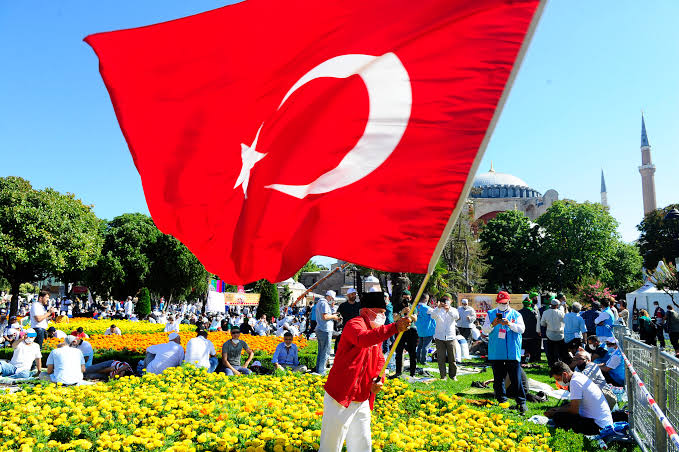Thousands of worshippers converged on Istanbul’s Hagia Sophia on Friday for the first Muslim prayers since the museum was reconverted into a mosque by a presidential decree.
SEE ALSO: Trump wants daughter, son-in-Law to leave White House – Reports
Most prominent among the faithful was President Recep Tayyip Erdogan, who prayed front and centre inside the nearly 1,500-year-old monument.
A “dream from his youth” had come true, he said on July 10, after signing the order converting the storied monument, revered by Christians and Muslims, into a mosque.
Removing his face mask and wearing a white prayer cap, Erdogan recited verses from the Qur’an over a microphone before the prayers started.
He later told reporters that 350,000 people had performed Friday prayers on the premises.
The marble floor was covered with a bright turquoise carpet, while white curtains were installed to shroud intricate mosaics of the Virgin Mary, baby Jesus and other Christian symbols at prayer time.
A large brown panel with verses from the Qur’an sheathed scaffolding set up for ongoing restoration work at the UNESCO World Heritage site.
Erdogan on Thursday unveiled a green sign with gold lettering in Turkish, Arabic and English, in front of the iconic site stating, “The Hagia Sophia Grand Mosque”.
Thousands of people prayed in the blazing sun in the sprawling square between Hagia Sophia and the Blue Mosque, another historic site.
Scores thronged security barricades, hoping to get past.
A large screen and speakers were set up in the square, broadcast footage showed.
Two hours before the prayers started, Istanbul Governor, Ali Yerlikaya, said the segregated areas outside were filled to capacity and the authorities had stopped people entering over concerns about the spread of coronavirus.
Erdogan was accompanied by cabinet members, including his son-in-law Finance Minister, Berat Albayrak, and other top officials.
Hagia Sophia was built by Byzantine emperor Justinian I in 537 as the largest church in Christendom.
It was converted into a mosque following the Ottoman conquest of Constantinople, modern-day Istanbul, in 1453 by Mehmet II, known as the Conqueror.
Its status was changed to a museum through a 1934 decree signed by Mustafa Kemal Ataturk, the founder of the modern Turkish republic.
On July 10, the Council of State, the country’s highest administrative court, nullified the decree signed by Ataturk, which ensured Hagia Sophia’s museum status for 86 years.
A UNESCO World Heritage site since 1985, Hagia Sophia is visited by millions of tourists every year.
Erdogan pledged to keep it open to tourists and welcome those of all faiths, pledging that entry will now be free.
Recitations from the Qur’an will continue for 24 hours, and Hagia Sophia will stay open overnight, state media reported.
Muslim prayers will be held five times a day.
The move has dismayed Turks, who view Hagia Sophia as emblematic of their secular constitution.
But it was not roundly condemned by opposition politicians.
The United States, the European Union, Russia, UNESCO and church leaders expressed concern at the change in status.
But Erdogan insisted it was Turkey’s “historical and sovereign right’’.
Orthodox Church leaders in the U.S. and Greece were to hold “a day of mourning”.
Greek media reported that bells tolled and flags were flown at half-mast at churches across the country.
Later on Friday, Archbishop Ieronymos II will hold a special mass at the Athens cathedral.
Archbishop Elpidophoros, Head of the Greek Orthodox Church in the U.S., tweeted that he met President Donald Trump and Vice President Mike Pence on Thursday to discuss “our grave dismay” at the reconversion.
Pence said the U.S. would stand with the Greek Orthodox Church in calling for Hagia Sophia “to remain accessible as a source of inspiration and reflection for every person of every faith’’.
Erdogan, who champions Ottoman symbolism and lauds Mehmet the Conqueror, has called the conversion a “second conquest”.
“Now this place has returned to its original; it was a mosque and has become a mosque again,’’ Erdogan said after visiting Mehmet’s tomb.

